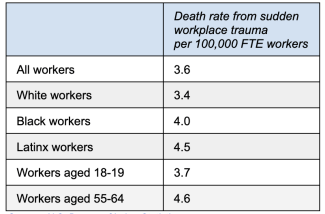20 Dec 2022
For immediate release – December 20, 2022
Contact: Melissa Moriarty, mmoriarty@nationalcosh.org, 605.505.7135
National COSH on 2021 Workplace Deaths:
Too Many Lives Lost, Urgent Action Needed
Disparities in death rates for Black, Latinx, Younger and
Older Workers Demand Attention, Say Safety Advocates
LOS ANGELES – During 2021, 5,190 workers died from sudden trauma on the job, according to data from the U.S. Bureau of Labor Statistics (BLS).
The BLS reported that a worker was killed every 101 minutes in 2021. If this rate of preventable workplace fatalities has not been reduced in 2022, it means that at least 64 men and women have died since the agency issued its press release on Friday morning, December 16.
“Too many lives are being lost from preventable causes,” said Jessica E. Martinez, MPH, co-executive director of the National Council for Occupational Safety and Health (National COSH). “This unacceptably high death toll represents thousands of people taken away from their loved ones and thousands of empty seats at holiday celebrations in the coming days. And this does not even include the far greater number of workers who died from COVID-19, or long-term exposure to asbestos, silica or other toxic hazards.”
“We need an urgent wake-up call to our employers and our government,” said Martinez. “Listen to workers. Enforce our safety laws. Remove known hazards, and let’s work together to make sure every worker comes home safely at the end of every shift.”
In addition to deaths from sudden workplace trauma, which typically takes the lives of some 5,000 workers every year, an estimated 95,000 workers die each year in the U.S. from respiratory, circulatory and other diseases caused by long-term exposure to preventable occupational hazards.
There is no effective nationwide tracking of workplace-related exposures, illnesses and deaths from COVID-19. But data from the One America Insurance company – based on claims submitted for life insurance policies – shows that death rates for people aged 18-64, the primary working age population, have increased by 40 percent over pre-pandemic levels.
An increase in the number of deaths from workplace trauma might have been expected in 2021, since there were more workers on the job working more hours than during the peak pandemic year of 2020, when many workplaces were shuttered or operating on reduced schedules.
But the rate of workplace deaths also increased in 2021, to 3.6 deaths from sudden trauma for every 100,000 full-time equivalent (FTE) workers. That represents the highest workplace death rates recorded since 2016, and an increase from 3.4 deaths per 100,000 workers in 2020.
The BLS data also reveals alarming disparities in death rates, based on the race and age of affected workers. As the table below shows, Black and Latinx workers are suffering deaths from workplace trauma at higher rates than white workers. Workers aged 18 and 19 and workers over aged 55 are also experiencing disproportionate risks.

Source: U.S. Bureau of Labor Statistics,
Census of Fatal Occupational Injuries (CFOI), 2021
The 653 Black workers who died from workplace trauma in 2021 – the highest ever recorded by BLS – represented 12.6 percent of all fatalities, an increase from 11 percent of all fatalities in 2020.
“Our safety laws are crystal clear,” said Martinez. “Employers are responsible for providing a workplace free from known hazards — and that means for all workers, regardless of age, gender, race or ethnicity. We must address the discrimination and structural inequality which put some workers at greater risk, and confront these issues while also raising the bar to make every workplace as safe as possible, every single day.”